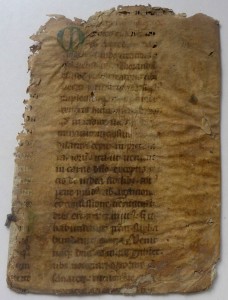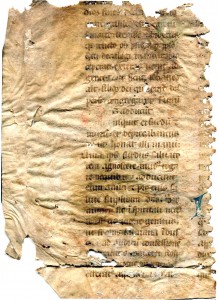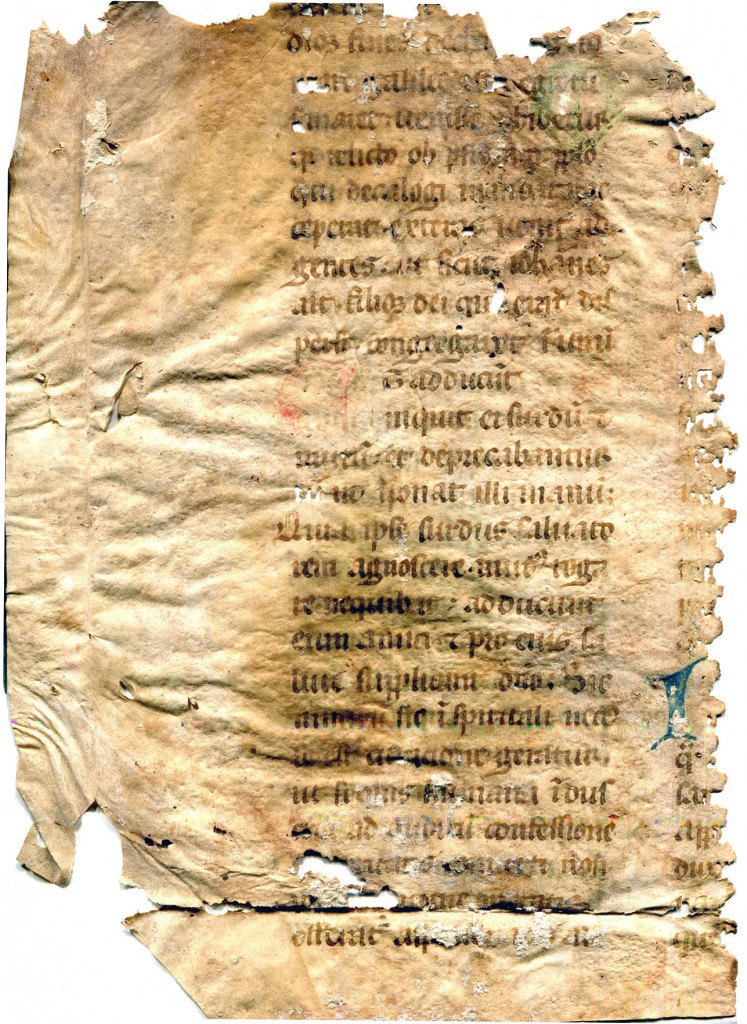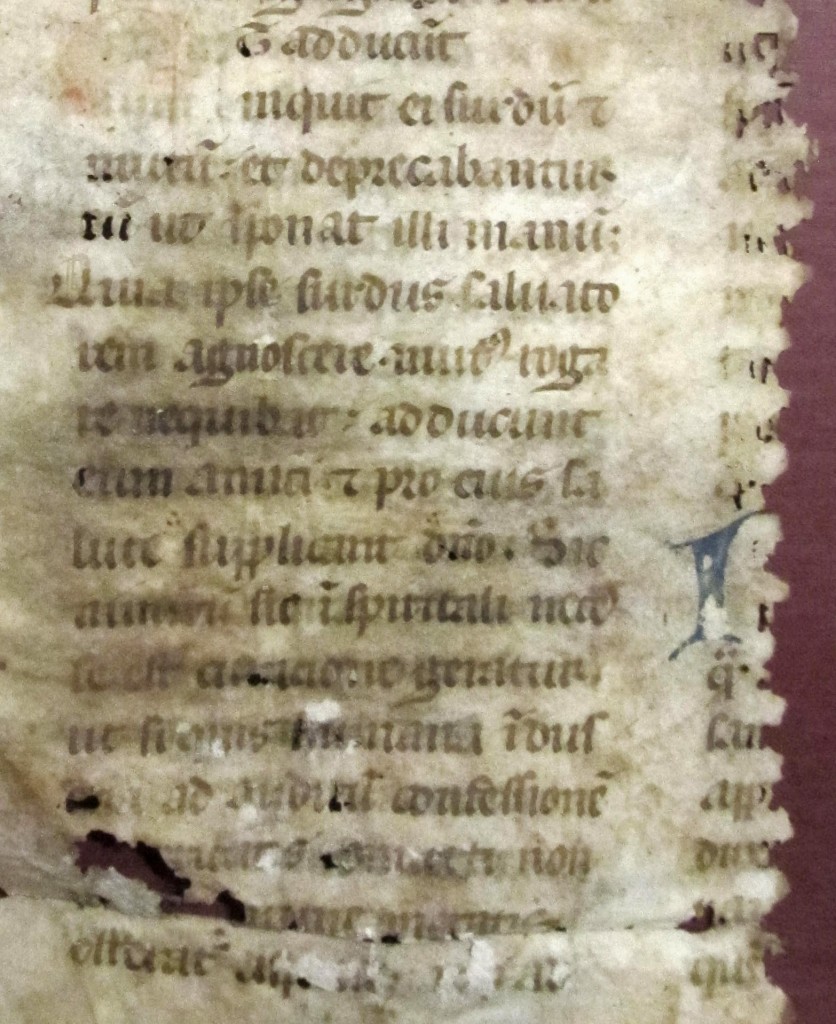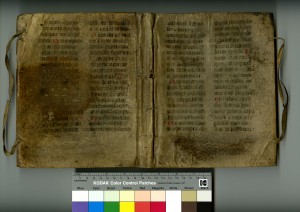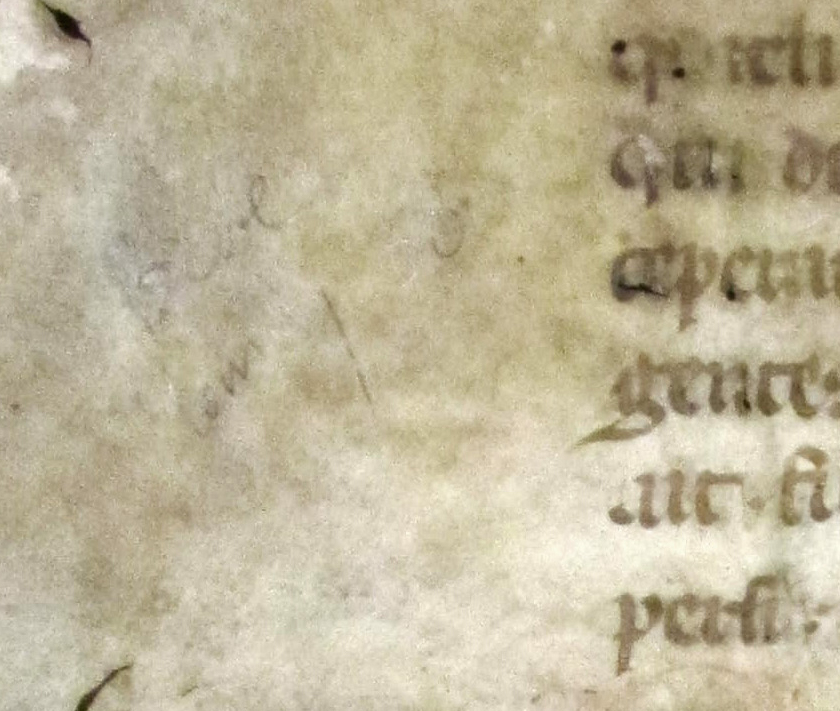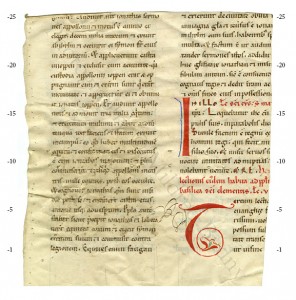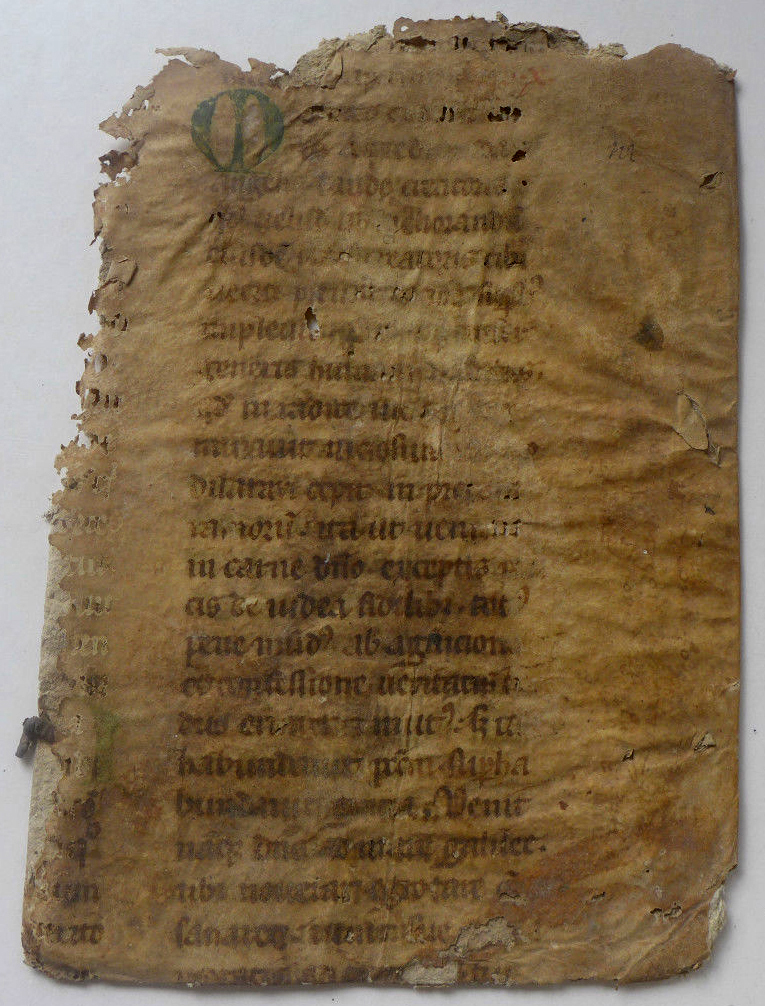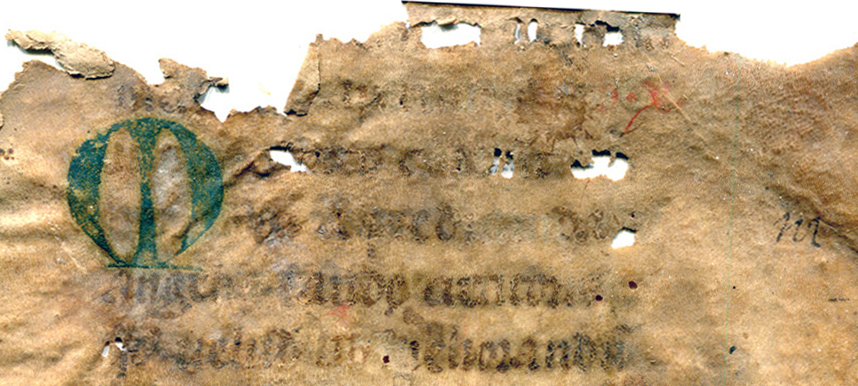A Reused Part-Leaf from Bede’s Homilies on the Gospels
October 30, 2016 in Abstracts of Conference Papers, Manuscript Studies
Bede on the Gospel of Mark
A Part-Leaf from a 14th-Century Large-Format Copy
of Bede’s Homilies on the Gospels
(Perhaps Other Texts Too)
in Double Columns of 26 or More Lines
in Latin,
Perhaps Made in France,
Reused as a Part-Cover for Something Else, Now Discarded & Lost
Yes, we know. Don’t know much about this part-leaf. Why should we bother you?
You might know something, and/or, you might like to know something. (My Kind of Person.)
I’m going ahead on the principle that Something Is Better Than Nothing. (Ever the Optimist. Gotta Hope For Something Good.)
Here Goes.
[Continuing our series on Manuscript Studies, Mildred Budny reports the identification of a reused and cut-down vellum Latin manuscript leaf extracted from a copy of Bede’s Homilies on the Gospels, made probably in the first half of the 14th century, perhaps in France. Identifying the text makes it possible to recognize which side of the leaf was the original recto, and which the verso. And there’s more to tell.]
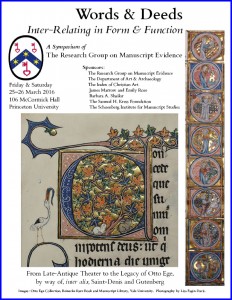 The extracted and reduced leaf was converted through reuse into part of the cover or wrapper for some volume or other, now unknown. At some point, at least by the year 2016, the part-leaf was removed from that interim position and offered for sale on its own online. It has come to its present owner recently, without record of the provenance of the leaf, or the nature and contents of its former volume, let alone of its original manuscript.
The extracted and reduced leaf was converted through reuse into part of the cover or wrapper for some volume or other, now unknown. At some point, at least by the year 2016, the part-leaf was removed from that interim position and offered for sale on its own online. It has come to its present owner recently, without record of the provenance of the leaf, or the nature and contents of its former volume, let alone of its original manuscript.
As characteristic for the problems presented by such discarded and commercially transferred medieval manuscript materials, we must resort to examining the evidence of the material itself. Good thing, it may be, that we and other colleagues have some experience with such tasks.
Have a look, for example, at the discoveries reported in our our blog on Manuscript Studies and our colleagues’ contributions to meeting the challenges which dismembered and dispersed fragments pose, as for our 2016 Symposium on Words & Deeds and its downloadable Program Booklet.
The Thing’s The Thing
This time, let’s start with the Thing Itself. Perhaps that is the (rather than a) Way To Go.
Whatever Works, Could Be?
And so, here we Go. First some Pictures, then Descriptions and Observations. We conclude with Questions. The Questions leave upon some Better-Informed Questions. Dig In!
*****
Starting Points
The text is identifiable as parts of one (or more) of the Homilies on the Gospels in Latin by the prolific Anglo-Saxon author Bede (672/673 – 26 May 735). Studies of that author, his texts, their intentions, their transmission, his influences, his impact, and his world are many, as listed in part in an ambitious Bede Bibliography, and the studies continue to increase on many fronts. Some of my own publications include close study of some manuscripts of his works in prose and poetry, including his Life of Saint Cuthbert, his Ecclesiastical History of the English People, and his treatises On Orthography and On the Reckoning of Time. (See here, Numbers 12, 15, 32, and 49.)
Here we focus on the artefact in question.
Size & Shaping Up
The remnant now measures at most circa 30.5 cm × 21.3 cm. As far as we can tell, it is — and was — a single leaf, rather than a bifolium (or folded pair of leaves from a single animal). The Owner, inspecting its characteristics for these purposes, finds no trace of any folding, or any stitching holes, in the space between columns.
The mitred corner cut across the lower outer corner of the leaf and the single foldline respectively at the outer edge and along the lower edge (more-or-less along the baseline of the penultimate line of script) attest to the pattern of reshaping the leaf for its next use as the wrapping of a pasteboard cover. At the side of the leaf, the fold produces a narrow stub extending farther into the original outer margin of the leaf.
Despite their appearances, the foldline and stub cannot pertain to an original “gutter” of the leaf, by which it and its conjoint stub were nested into the gathering of leaves in its medieval binding. The course of the original text from one side of the leaf to another establishes that the surviving portion represents most of the outer column on each side and shreds of the inner column next to it, with the broad, and perhaps full original, expanse of the outer margin at the edge along which the foldline intrudes.
The leaf may have been wider, perhaps as much as by 14 cm, and higher, perhaps as much as by 5 cm. While the lower edge of its columns of text survives, the upper edge of its columns has lost a line or two of script, to judge by the gap in its text, turning from the bottom of the recto to the top of the verso, when measured against the standard editions of the homily. (Cited below.)
Two Sides: Front & Back
First comes Front and Back. How do we know which is which? OK, we “cheated” (not the right word) by making the choice for showing you the pictures in an order on the basis of educated observation. It Is What We Do. (Choosy.)
Besides, we don’t want to waste your time before revealing the Answer to the Question we had to try to answer anyway. Front Or Back Or What? First we show, then we tell. You can do the same, and we’d like to hear from you.
Side 1
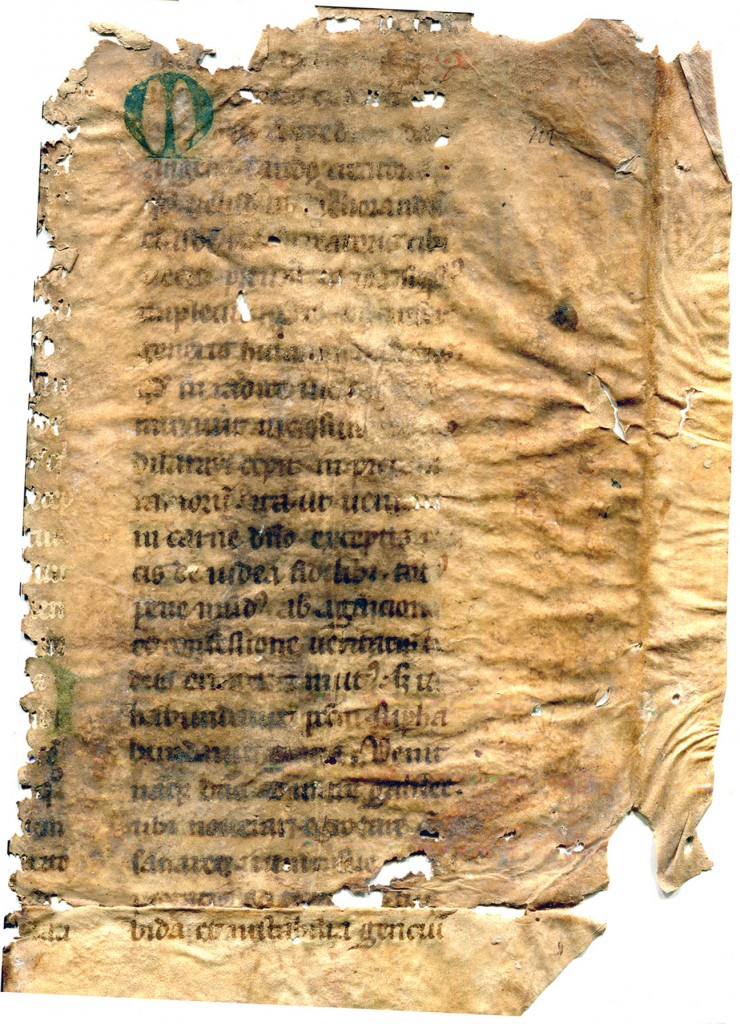 Side 2
Side 2
The Leaf
Yes, you saw 2 different views of both sides of the leaf. Here we offer some more.
Why should we bother you with any other views? Your time is valuable.
Why, indeed, bother you? Because the different photographs show other things. (Demonstrated, for example, in the 2015 version of our Style Manifesto, downloadable here.)
You know, like your School Yearbook photograph, your Driver’s License photograph, your Graduation photograph, or any other photographs that record a Moment Worth Photographing in your Life. (Wedding, Divorce, Mugshot, whatever. Meaning No Disrespect.)
I don’t presume that you have any, or many, of such occasions in your life to merit Mugshots. People have different voyages, just as Manuscripts (emanating from People) do.
Simply, and respectfully, here I make some suggestions that might correspond with one or another of your own experiences. Just to exemplify that Manuscripts show different sides, including their various sides.
Remaining on Point, I mention. PhotoOps for some Manuscript Divas are described and illustrated happily for obliging Manuscript Groupies. You know, they helped to launch our blog on Manuscript Studies. Love ’em!
But let’s focus on this bedraggled leaf. A candidate, don’t you think, for the “Foundling Hospital” for Manuscript Fragments?
Front & Center
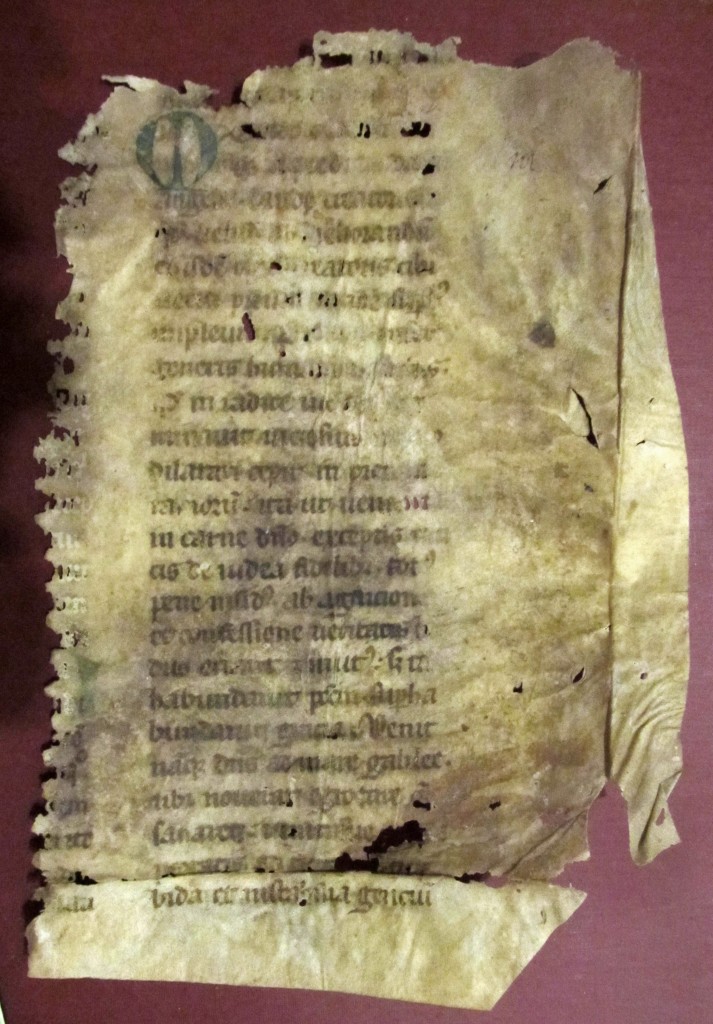 Back-Up Plan
Back-Up Plan
Bits of Information About Provenance
The Recent Seller
Now in a private collection, the leaf was purchased online from a seller with the address of “33380 mios, Aquitaine“, in southwestern France. The Commune of Mios lies in the Départment of Gironde in the Region of Nouvelle-Aquitaine. As far as we know, the seller has nothing more from this manuscript, nor do we know of other leaves in other hands.
Of course, it is not necessary, nor even appropriate, to conclude that the original came from nearby, was made nearby, or dwelled for most of its history nearby, just because the manuscript or this part of it landed in the hands of that seller. Added to that, the wonders of internet commerce allow for the seller to use an address which might or might not correspond with his/her place of residence and/or wherever the item was discovered or recovered.
Wonders never cease, hey?
The Modern Binding and Its Contents
The odd “scraps of pulped document” (reported by the Owner) remaining here and there pasted upon the surface of the fragment indicate that the binding for which the leaf was re-purposed as a cover or wrapper would have been made sometime between circa 1650 to 1700. After removal from that modern volume, the remnants of those pasted bits are visible, for example, over parts of the lower lines of column b on the original verso. Here:
So, that binding seems to have been made circa 1650–1700. Presumably it formed the cover for some sort of ledger. A few threads from its sewing remain in a pair of tufted groups extending from the lower left-hand side of the recto. The remains of vellum ties appear opposite the binding-cords. They are visible in the photograph shown at the top of this post.
The Reuse, Title Included
A photograph under black light reveals more traces of the reuse and its intended purposes. Here:

Detail of the Recto of the Part-Leaf Turned Sideways. The Added Title. Under Black Light. Photograph by the Owner, used by Permission.
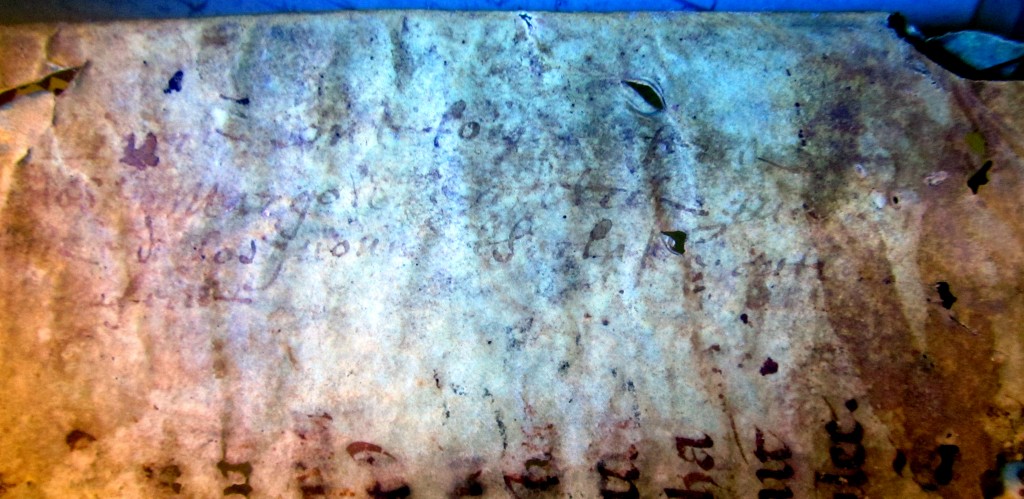
Close-Up of the Recto of the Part-Leaf Turned Sideways. The Added Title. Under Black Light. Photograph by the Owner, used by Permission.
Turned sideways in the margin at the right-and-side of the recto, a set of very faded notes in ink in 4 lines occurs in a 17th-century hand. Set out in 4 lines, the script is somewhat sprawling. Even with the aid of black light, the lettering is not readily or fully decipherable, but that form of lighting enhances the forms.
As a “best guess”, under that lighting, the inscription appears to read, in parts:
. . . terres de Losguonn . . . sur la . . . ” in line 3, with the name of a “Margott” in line 2.
Could you take it from there?
A Sense of Place
Presumably the note or title reports that the enclosure was some sort of land inventory or ledger. (“Terres” = “Land” in French.)
Considering the name of the place, we observe that the word losgann in Scottish Gaelic means “frog”, “toad”, “wretch”, “childhood” (rarely), “spawn”, and “jellyfish”. Some places, including a loch, carry that name.
Among possible candidates for the place name closer to the recent seller (as a point of departure), we observe that a place spelled Lesguenn appears within the Department of Maine-et-Loire in west-central France. For example, it is recorded as such in the issue for “Samedi 31 Janvier 1903” of Le Finistère, listing the amount of a subscription by “M. Guichard, instituteur à Lesguenn (Maine-et-Loire), 2 fr. 20” in support of a delegation to Paris by the “marins-pêcheurs“. Occurrences of the personal name Lesquen are recorded, for example, in Maine-et-Loire. Variants appear to include such forms as Lesven. More work might reveal more precisely the terms of the note.
The process could resemble the information obtainable in our blogpost on a Cover Up involving a reused medieval Psalter leaf and a modern French paper notebook, which still stand together, after reaching its American collector from a source in France. That relic also has a double pair of vellum ties, like the New Leaf (or rather Part-Leaf) from a 14th-century copy containing Bede’s Gospel Homilies or part thereof.
More clues, perhaps? Faint notes in a modern hand stand at a diagonal rising to the right in the outer margin on the verso. Can you decipher them?
The Original Text
The surviving portion of the leaf mostly retains parts of at least one of Bede’s Homilies on the Gospels. Bede’s homiletic works comprise only his Homilies on the Gospels in Latin. They are devoted to specific occasions around the course of the liturgical year.
The text of these homilies could serve for reading in sections, or lections, like the Homilies on the Gospels by Bede’s model Gregory the Great. (See here, Number 5, for an early Anglo-Saxon copy of Gregory’s Gospel Homilies, Book II only surviving.)
Such a case for lections from Gregory’s Gospel Homilies and from other texts (in a copy probably made in Italy) is exhibited in our blogpost on a Part-Leaf from a Large-Format Lectionary. There, too, the discarded leaf was cut down and reshaped for its post-medieval use as a folder or wrapper. There, too, the reused leaf was removed from its secondary contents and sold on its own in Europe to arrive in the United States — although that owner could inspect the item for sale in the shop of the seller at a known address in Florence.
Editions of Bede’s Homilies
(Plus Access Issues for Scholarship)
Before tackling the portions of text on the New Part-Leaf, we provide some reference points. Plus some observations about access to reference materials.
As always nowadays, there are the Haves and the Haves Not-So-Much when it comes to researching on the internet. Some scholars, academics, and others have available at their fingertips the full range of resources, hefty subscriptions for access included, or subsidized. Some do not.
A bad concomitant of this commercially-driven series of portals or barricades to available knowledge via digital sources is that some research simply cannot advance, except by resourceful access to what might be freely available. Often those sources, with out-of-copyright materials, may be long out-of-date.
It may surprise you, but neither the Research Group on Manuscript Evidence, although a 501(c)(3) nonprofit educational organization, nor its Director (Yours Truly) is granted access, unless we might pay for them, to institutional educational libraries which require admission fees of one or another financial form to outsiders as so defined, because we are regarded as outsiders. These admission fees are steep, and getting steeper. It is necessary for our Director, if she requires such access and can pay for it, to devote monies from her part-time work (usually dedicated to subsidizing other parts of her/our research and activities). Plus the costs of travel, parking, and other aspects of journeying to consult one or another of those collections, even as a paying outsider, which to not grant online access to their subscription materials to any “paying outsider” except on the premises and during working hours. Nor do they (so far as I have encountered) permit access at all to such features as Direct Borrowing from other institutions. Such conditions do not allow the research to progress speedily, and it is costly.
If you believe that it would be useful to encourage the research work of the Director for the Research Group on Manuscript Evidence by contributing a donation toward the fees of library access, please visit our Contributions & Donations Page. We would be glad for your support and encouragement.
Back to the specific editions for the research in hand. (And now you know some of the gymnastic logistics which had to go behind it.)
A free website presents a scanned copy of a Latin edition of
- The Complete Works of Venerable Bede, Volume 5: The Homilies, edited by J.A. Giles (London, 1843).
More recent materials can require admission charges, say by the price of the book or the dues (in one form or another) for access to a library not open freely to the public. Editions and vernacular translations of the Latin text include:
- Bede the Venerable, Homilies on the Gospels, translated into English by L. T. Martin. Cistercian Studies Series, 110 (Kalamazoo: Cistercian Publications, 1991)
- Bedae Venerabilis Opera, Pars III: Opera Homiletica, edited by D. Hurst, Corpus Christianorum Series Latina, 122 (Turnhout: Brepols, 1965)
With Bede’s homiletic oeuvre comprising his 50 Homiliarum Evangelii Libri II, the series in Hurst’s edition divides the homilies into 2 Books of 25 homilies each. Like those of Gregory the Great. No accident, that.
The Circumstances
As part of Bede’s series of Homilies on the Gospels in Latin, this one on the New Leaf is devoted to pronouncements upon Mark 7:31 etc (to verse 37), focused upon the healing of a man born both deaf and dumb. That is, the healing of the deaf mute of Decapolis, among the “Ten Cities” in the Southeastern Levant.
Within the cycle of the liturgical year, the intended occasion for this homily is Holy Saturday. A solemn occasion. (Solemn? To put it mildly.)
Different publications of the text, both in the Latin (as edited in several versions) and in English (as translated from a chosen edition), number the Homily In Question in different ways. For example, the modern English translation of 1991 by L.T. Martin describes it as Homily XXXVIII — in contrast to David Hurst’s Latin edition upon which the translation is explicitly based. That Latin edition numbers it, within the division of the Homilies In Question into 2 groups (Libri or “Books”) of 25 Homilies each. Which makes this one this Homily: Book II, Number 6.
The full series of Bede’s Homilies on the Gospels in Hurst’s edition spans printed pages 1–378. Not a short text. This Homily occupies his pages 220–224. The span of text on the Leaf In Question occupies only part of 2 pages therein.
Which allows us to guess already that, if the original manuscript contained the full set of Bede’s Homilies on the Gospels, it would have spread out on many pages. I don’t feel the need to conjecture how many pages per spread, because we are not — yet — entitled to think that the full span of the former manuscript with this leaf must necessarily have included the whole text.
Let’s see what we might know.
The Text Up Close
The scraps of letters at the ends or beginnings of lines on both sides of the leaf represent what remains from the first, or the second, column of 2 columns on each page. The present edge of that column is ragged, jagged, and perhaps worm-eaten, with no more than a few letters left over.
On the opposite side of the surviving column, there stands the full extent of the inner margin, the inward-fold of the original gutter of the leaf, and a narrow stub with a more-or-less clean straight edge. It seems a safe bet that this stub is original to the manuscript, so that the leaf would have formed a singleton, inserted or nested somehow into its quire and its volume by means of the hook-like fold provided by the leaf-plus-stub. The direction of the fold makes it clear that its interior turned Side 1 to the verso and Side 2 to the recto of the leaf.
Below a beheaded line of text, the first intact lines of text in the mostly-preserved column of text on Side 1 begin with the phrase Merito clausit os a predicanda, which opens with an enlarged, built-up initial M presented in bright green pigment. Its closed, rounded form, resembling a bulging O flanking a central vertical stem, stands inset within the indented first 3 lines which make way to receive it.
With some gaps introduced through holes in the leaf, the text of this section starts more-or-less thus (indicating the transition from one line to the next by a forward slash /):
Merito clausit os a / praedicanda cum / angelis laude creatoris, / quod uelut ad meliorandum / ejusdem opus creatoris, cibi / uetiti praeuaricatione superbus / impleuit. . . .
This text corresponds to a portion close to the beginning of Bede’s Homily on the text of the Gospel of Mark, Chapter 7, Verses 31–37 (by modern numeration in chapter-and-verse).
According to editions and manuscripts, the text of the Homily itself begins: Surdus ille et mutus quem mirabiliter curatum a domino. The remnants of the damaged adjacent column presumably contain some parts of the text preceding Merito . . .
In Hurst’s edition, those parts extend from line 1 to mid-line 10 of his numbered printed lines. The portion represented by the bulk of column b, from Merito onward, corresponds to his lines 10–20.
Close inspection confirms that, line for line, the text of this Homily is mostly continuous — apart from gaps through damage — from that one column directly to the other.
With the aid of a Latin printed edition (such as Giles’s or Hurst’s), it is possible to discern that, given the standard, the continuous text from front to back of the leaf would originally have flowed thus, more-or-less (with the missing text supplied here in red):
. . . instabilia gentium [corda, in quibus noverat esse qui ad suam gratiam pertinerent. Et bene inter me]dios fines Decapoleos . . .
This span on the first column corresponds to about 14 lines of text in the Giles edition (free on Google Books). In the Hurst edition, the missing text at the top of column va amounts to about 1 1/2 lines of print: lines 20–22 of the numbered 172 lines of the whole Homily.
The text in the mainly-preserved column on the opposite side of the leaf (column va) concludes mid-word with
. . . offeratur aspectibus at[/que at sanandum supernae manus flagitur auxilium. . . ]
The Flow
The gaps from damage within the lines of script impose discontinuity upon the text. Were it a text otherwise unrecorded, it would be necessary, if deemed desirable, to scrutinize each and every letter trace so as to extract every element of the solitary witness. Not here!
Bede’s text travelled through many intermediaries, some of which survive, from his composition at his home monastery (or, rather, double monastery) of Wearmouth–Jarrow in Northern England in the early 8th century, before it reached the hands of the scribe(s) of this copy some 6 or so centuries later in a place of production as yet unknown. Some surviving manuscripts of Bede’s Homilies are listed, collated, and described, with a view to their value as witnesses to Bede’s original and variants upon it, in Hurst’s critical edition (1965). These assessments appear (in Latin) in his Praefatio and prefatory chapter on the Codices, which he ranked by Classes (pages viii–xxi) — as well as in the apparatus throughout the edited text. Some of those sources comprise early lectionaries (Classis III). The New Part-Leaf stands, albeit precariously, within a varied company of survivors, some with integral copies of the full set of homilies, but others not. With its text identified, it may now stand among them.

Monastery site and St Paul’s Church Jarrow. Photograph © Andrew Curtis via Creative Commons License.
As a guide to the former flow on the leaf, we might consult Hurst’s edition, again with the addition of forward slashes to establish cues for following the disrupted course, and with the introduction of some spelling variants (“[h]”). Following “impleuit”, there comes:
Et heu miser / generis humani defectus / quod in radice uitiatum / germinauit uitiosius multo / dilatari coepit in propagine / ramoru ita ut ueniente / in carne domino exceptis pau/cis de Iudaea fidelibus totus / paene mundus ab agnitione / et confessione ueritatis sur/dus erraret et mutus. Sed ubi / [h]abundauit peccatum super[h]a/bundauit gratia. Venit namque dominus ad mare Galilaeae / ubi nouerat aegrotare quem / sanaert. Uenit suae gratia / pietatis ad tumentia tur/bida et instabilia gentium / corda in quibus nouerat esse qui ad suam gratiam pertinerent. Et bene inter me/dios fines Decapoleos ad / mare Galilanea ubi aegrotum / sanaret uenisse perhibetur / quia relicto ob perfidiam populo / qui decalogi mandata ac/ceperat exteras uenit ad / gentes ut sicut iohannes / ait filios dei qui erant dis/persi congregaret in unum. /
Column a on the verso includes an inset 2-line red initial, mostly faded, for the next section, which opens with the Gospel citation
Et adducunt / inquit ei surdum et / deprecantur / eum ut inponat illi manum (from John 9:52).
Quia ipse surdus saluato/rem agnoscere mutus roga/re nequibat adducunt / eum amici et pro eius sa/lute domino supplicant [these 2 words inverted in MS]. Sic / nimirum sic in spiritali neces/se est curatione geratur / ut si quis humana indus/tria ad auditum confessionem/que ueritatis conuerti non / potest, diuinae pietatis / offeratur aspectibus at/[que ad sanandum eum supernae manus flagitetur auxilium . . .]
The text in the column concludes with offeratur aspectibus at[/que at sanandum supernae manus flagitur auxilium] (within line 33 of Hurst’s edition).
A few letters or parts of letters at the beginnings of lines in the next column
The fragmentary initial in green in column b presumably opened the statement Per digitos namque domini spiritus sancti dona significari et ipse docet dicens . . . (in line 43). Some of this transcription should, according to my rules here, appear in red letters. However, without tackling the painstaking work and guesswork of identifying which letters, and which parts of letters, still stand on the leaf, and without figuring out a way to indicate letters in the transcription as partly black and partly red (and to which extents), I invite you take this conjectured reconstruction as (in part) re(a)d.
The Span
The text in the mainly-preserved pair of consecutive columns (rb–va) corresponds to part of pages 220–221 in Hurst’s edition, from about (counting the few lines missing or only partly decipherable at the top of the first column) his Lines 9 (or so) to within Line 33. Equivalent to some 24 long lines of printed text. By this reckoning, the 2 other columns on the leaf may have contained a similar span, extending, say, to about Printed Line 57 by the end of column vb, and containing not only the preceding Printed Lines 1–10 of the Homily, but also the last part of some preceding text.
Perhaps it was the preceding Homily, if the manuscript contained other Homilies in Bede’s set.
In Hurst’s edition, Homily II.5 (pages 214–219) has 189 Printed Lines. That Homily, devoted to John 13:1–17, pertains to Good Friday (In Caena Domini). Just right as preparation for Holy Saturday and Homily II.6.
*****
Not much text is missing from the top of the leaf, although only there remains most of one of the original double columns per page. The surviving remnant retains 27 lines, more or less. Given the spacing of text per line (abbreviations included), we might conjecture that the missing text at the top of column a on the verso probably spanned 3 or 4 lines. So, we guess, the original columns on this leaf — presumably or perhaps on all/most/some others in the book — spanned some 30 or 31 lines.
The Condition
Over time, the ink of some letters has eaten through the leaf. This disorder is known in various other cases of vellum or paper. The effect resembles a literary form of lace or Swiss cheese.
Lectionary
There are traces of a section or lection number .x. It is flanked by medial dots, characteristically medieval methods for signalling roman numerals apart from the letters as such using the same forms. Other reused fragments reported among our Blogposts observe such numeration, ordinarily denoting a new textual component within a series, mostly for reading aloud as part of an ecclesiastical occasion or a lection in refectory or other communal activity.
The liquid splat to the left of the numeral on the Leaf in Question and its left-hand dot has mostly obscured a preceding remark in similar red pigment. However, that partly-obscured entry concludes, rather clearly, with an o in red, preceded by a few letters. The spacing, at any rate, seems to determine that the numeral x is the sole component of the numeral.
As a result of the blurring, it is to a certain extent difficult to decipher which Thing of a Series it is to which this solo numeral belongs. However, comparable circumstances strongly suggest, and almost certainly determine, that the partly effaced or blurred entry reports that Numeral X comprises a Lectio, or “Reading”, within a numbered series.
Anyway, the numeral X indicates that this item has a place at some remove from the beginning of the sequence. Who knows how many items followed in the original book as a whole.
Regarding the practice of preparing texts as lectionaries, and marking texts for lection, I commend these posts to you, with some further bibliography:
Part of the ‘Interpretation of Hebrew Names’
from a 50-line Lectern Bible
in the Vulgate Version
Part of a Leaf from the Saint’s ‘First’ Life
in a Lectionary
Reused as Binding Material
Different manuscripts, different problems, and some similarities.
*****
Script as Stylistic Cue
Appearing to postdate circa 1300, the script is presumably the product of a center in France, although it is not yet clear which region may have made it. Some of the letters are unusual, as with the flamboyant final s.
*****
We thank the Owner of the leaf for information and permission to research and publish the leaf. Do you know of any other parts of the same book to which it formerly belonged? Please let us know.
P.S. If you like our blogposts and the research reports which they publish freely, please let us know. Also, if you would like to encourage and support more of them, for example with a contribution toward the library-access fees required by institutions of our Director, please visit our Contributions & Donations Page. We welcome your contributions, and they may be tax-deductible!
*****

